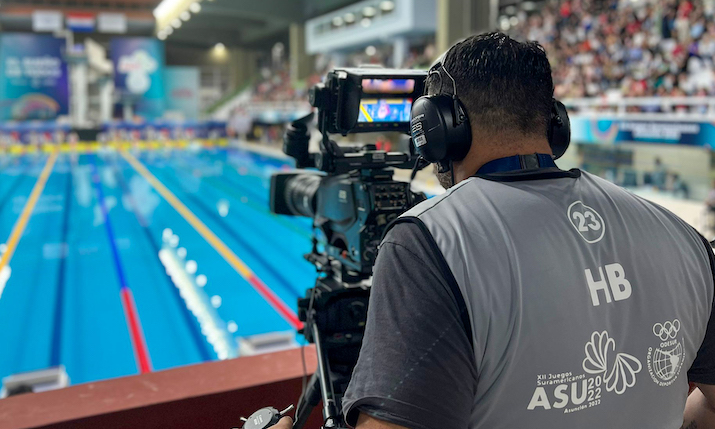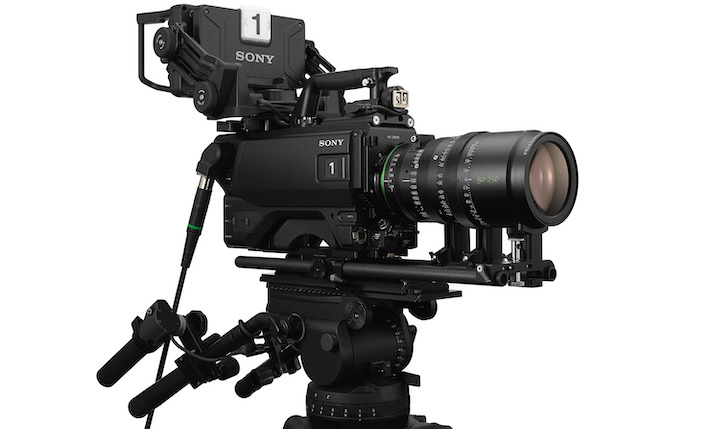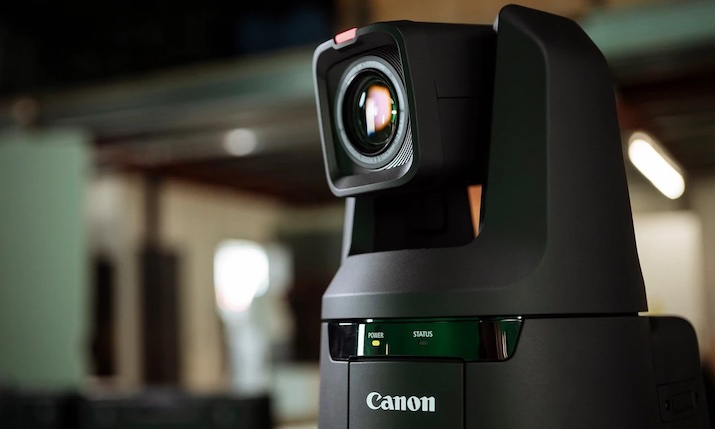Tech focus: Camera and lens manufacturers help get viewers closer to the action

ES Broadcast equipment in use poolside
SVG Europe’s tech focus series continues with Canon Europe, ES Broadcast, Panasonic Connect Europe and Sony sharing the latest developments in the world of cameras and lenses.
With storytelling increasingly in focus among sports directors, the cameras and lenses chosen to capture the excitement and emotion of a live event are ever more important. From cinematic shots to super slow-mo closeups and everything in between, there’s a huge variety of camera and lens options to choose from to perfectly set the scene and share the story of the game. But what are content creators actually looking for and how are technology providers delivering?
Josh Lomas, technical account manager, at ES Broadcast, begins: “From a camera perspective, apart from the best-looking pictures in the world, high frame rate (HFR) capability is the primary request from our customers, to allow for smooth imaging of fast-paced sports such as football and Formula 1. As consumer investment in the latest TV technology progresses, so the expectation not only of high-quality resolution but also the experience-enhancing images delivered by high dynamic range (HDR) and wide colour gamut increases, so typically cameras need to be able to support this.”
Clear, stable images are also front of mind when it comes to lenses, according to Ryan Kamata, senior marketing manager at Canon Europe. He says: “For lenses, no matter what tier the broadcaster is operating in they will always be looking for a number of key aspects, one being image quality. By this I refer to a sharp clear image and minimal chromatic aberration, ghosting and flare to give their viewers as lifelike an image as possible. Another would be down to features and operability, such as the availability of a wide range of focal lengths, a stabilised image and virtual compatibility, and a robust form factor.”
“Robotics, AI and facial recognition are current hot topics when speaking with our customers”
While image quality is undoubtedly important, budgets also have to be considered as Paul de Bresser, product manager, cameras at Grass Valley, highlights: “Every sports director wants to tell their story of the game and is always asking for the most and best cameras to create that emotion for the viewers. However, the budget per production determines which cameras can be used and this is of course more for Tier 1 productions versus Tier 3 productions.”
While budgets are undoubtedly tighter than they were even a decade ago, this isn’t necessarily leading to lower quality. In fact, the opposite may be true, according to Stefan Hofmann, head of sales engineering MEBD proAV (Europe, Middle East and Africa) at Panasonic Connect Europe.
“While budgets are decreasing, technological advancements have led to quality improvements, providing the same, if not better quality at a lower cost,” he explains.
“Simultaneously, the industry is realising that reaching the 80% quality mark is relatively easy; it is the last 20% that generates the additional cost. Production companies know this and rightfully question the importance of that final 20% when the quality of content is already at a high level, especially since the benefits of the final fifth are not acknowledged by consumers and therefore rarely needed.”
Telling the story
As technology continues to advance, so too does the director’s desire to present images in a new, innovative way, something which has led to the relatively recent adoption of a cinematic aesthetic in sporting broadcasts.
“This generates a better connection with the viewer, further enhancing their experience of the already dramatic nature of a major international tournament,” adds Lomas. “It will be interesting to see how sports broadcasting adopts the recently arrived Sony HDC-F5500, which is a dedicated S35 system camera designed precisely to deliver full frame, shallow depth of field storytelling while slotting into a live workflow.”

Sony’s HDC-F5500 is an S35 system camera designed to deliver full frame, shallow depth of field storytelling
In addition to the F5500, Sony also points to its large sensor camcorders, such as the ILMEFX30, ILMEFX3, ILMEFX6, or PXWFX9, that can be used to achieve these specialist shots.
“They can be easily used with wireless transmission systems allowing specialist shots to be easily captured and integrated in with traditional productions,” explains Anthony Kable, CC group manager, Sony Australia. “The large sensor PTZ cameras and camcorders are able to be easily integrated as they can be colour matched and controlled with the same systems as they are from the same manufacturer.”
Canon’s Kamata adds: “While we consider the 2/3” camera system will still remain as it plays an important role in sports production, we do feel there is a rising demand for large-format camera systems to achieve a distinct cinematic look. What the cinematic look achieves with its rich colour reproduction and shallow depth of field can capture the emotions of the crowds as well as tell the story from a specific angle. This can be seen in the large increase in sports documentaries now being produced that are shot using large format cameras and lenses, which has shown a different way of offering incredible and engaging footage to audiences. Canon’s Cine Servo and Compact Servo lenses offer a perfect marriage between the familiar ENG form factor and functionality paired with our Cinema optics as well as offering broad focal length coverage across the range.”

Paul de Bresser, Grass Valley
De Bresser, however, suggests it’s the skill of the director, rather than a specific camera, that will make sure those unforgettable moments so often seen in sports are captured for all to enjoy: “It is not the camera that creates this emotion that the director wants to see on the coach or players’ face, it is the quality of the camera operator who creates the look the viewers are seeing on the screens at home. By understanding the game, framing and focusing at the right time, they can make this perfect shot. So it can be done with any camera around the pitch, from a normal single speed camera, to a wireless camera in the crowd, to a super slow-motion camera showing a close-up of the player scoring a touchdown.”
Remote production
One growth area that is widely agreed upon, however, is the greater use of PTZ cameras, thanks to the growth in remote production.
“Pre- and-post-match interviews are increasingly conducted using PTZ cameras controlled remotely rather than studio cameras as a result of budgetary constraints,” adds Hofmann. “They are also increasingly replacing studio cameras, either in a hybrid environment, in conjunction with studio cameras or productions that are solely reliant on PTZ cameras.”
“The innovation of NDI PTZ cameras from the likes of Panasonic and NewTek allow for advanced flexibility and connectivity via only one cable, within a designated network, eliminating the need for expensive, long cable runs and complex setups that would typically take significant time in managing and maintaining,” adds Lomas.
Remote production has also created a need for cameras that can be easily monitored, configured and controlled across a network.
“The ability to easily remotely control large quantities of cameras is a requirement that has existed for quite a while, but customers now want to increase the level of control and also work with products located in remote locations,” adds Kable. “To more easily enable this, we have implemented ember+ support to allow simple integration with automation systems, we have also introduced the new CNA-2 unit that allows enhanced control and provides a federated system allowing multiple locations to easily act independently or as a single larger system.”
Kamata adds: “IP control and transmission is a rising requirement which means camera manufacturers need to look a lot more into the entire system when creating new products. With 4K UHD being broadcast on a greater scale than before, it is key that we look at ways of retaining powerful image quality with seamless remote production requirements.”
From a lens perspective, UHD-capable lenses are becoming the norm, regardless of whether a production is in HD or UHD. “Combined with the advanced sensor of UHD-generation cameras like the HDC-4300 or LDX 86N, these lenses greatly enhance the image quality delivered to the viewer, a key consideration in the world of HDR and HFR,” adds Lomas.
Recent developments here include the Fujinon HZK25-1000mm, which boasts the world’s highest 40x zoom and a focal length of 1000mm. The lens achieves optical performance which exceeds 4K and facilitates the use of cinema cameras, offering cinematic visual expressions such as shallow depth-of-field for beautiful bokeh in live coverage of sporting events.
“5G will become a commonplace tool in enabling live wireless sports broadcasting in the future, providing the ability to broadcast moments not previously seen due to wired limitations”
Looking to the future and there are plenty of developments still in the pipeline.
“Robotics, AI and facial recognition are current hot topics when speaking with our customers,” says Lomas. “With the ability of AI to be incorporated within live broadcast, this opens up the potential of further in-game/in-race analytics that can be included within the production of the broadcast, presenting the viewer with better statistics of a footballer, for example, creating a greater immersive and engaging experience, ultimately broadening viewership.”
Hofmann, meanwhile, expects to see more demand for wireless cameras as 5G becomes more widespread. “There are a number of scenarios in sports broadcasting where a wired camera isn’t suitable, whether this is interviewing fans outside a stadium or drivers in the F1 paddock. While there are some wireless camera systems that utilise 4G and bonding technology, there is often a limited understanding of the quality of service, which can lead to transmission disruptions and therefore isn’t recommended.

PTZ cameras are being utilised more in sports broadcasting
“5G will become a commonplace tool in enabling live wireless sports broadcasting in the future, providing the ability to broadcast moments not previously seen due to wired limitations. The real key will be combining existing equipment in the market with the 5G technology needed in one product.”
De Bresser, however, points out that many features already available are not being fully utilised. “In some cases, current cameras offer functionalities that are not yet used by all users, such as native UHD high speed operation, UHD wireless cameras, HDR operation in SMPTE-2084 and ICtCp standard, etc.
“The requirements for the HDR formats used in live productions may still change and the greatest possible flexibility in the HDR format support is therefore a typical customer requirement. However, the demand for a native IP connection between the cameras and the infrastructure will in all probability continue to increase significantly.”
Kamata concludes: “The way sports broadcasts are being captured is developing at an exciting rate, with the growth of large format capture and increase in IP workflows as well as exploring new ways of making sports content more engaging with the audience using virtual methodologies. We are working closely with the industry to make sure that we can develop and deliver the best solutions possible for all tiers of production.”
The esports angle
In addition to traditional sports, the esports market has also increased its focus on reliability and production values in recent years as participation has boomed and penalties have been imposed for off-air time. This has led to more investment in professional broadcast equipment, including cameras.
“Camera-wise, esports is a completely different ball-game to even the most complex traditional sporting event,” says Josh Lomas at ES Broadcast. “100-player tournaments might have 12 in-venue channels operating, but on top of that there will be player cams – at least on a team, if not every single competitor. So then you’re talking about anything from 20 to 100 remote minicams (and probably several PTZs). Let’s not even think about the implications that has on routing and switcher channels!
“From a workflow perspective, a live esports event broadcast isn’t too dissimilar to a conventional television broadcast, though with the potential number of camera streams workflows may often need to be modified to segment or manage those camera angles.”

